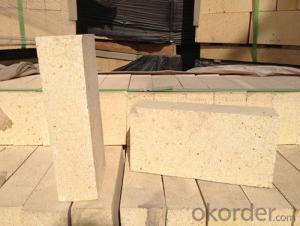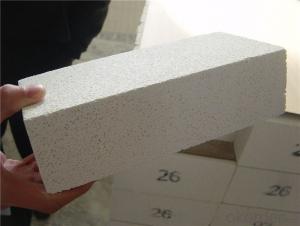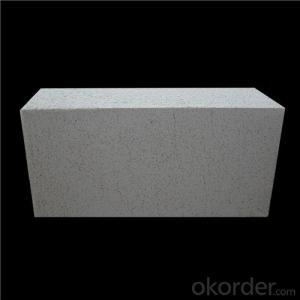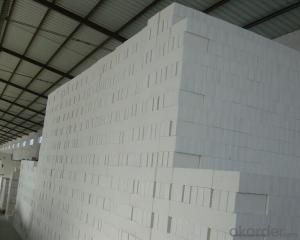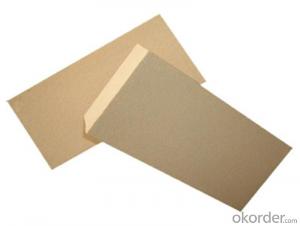Insulating Fire Brick GJM26 - High Quality Insulation for Fire Safety
- Loading Port:
- China Main Port
- Payment Terms:
- TT OR LC
- Min Order Qty:
- -
- Supply Capability:
- -
OKorder Service Pledge
Quality Product, Order Online Tracking, Timely Delivery
OKorder Financial Service
Credit Rating, Credit Services, Credit Purchasing
You Might Also Like
General Information
CMAX insulating firebricks are classified under temperature between 1300℃ to 1700℃, manufactured from high purity alumina clay.
Feature
Light weight and low thermal conductivity
Low heat storage
Low iron and impurities
High thermal shock resistance
Application
CMAX insulating firebricks can be used as a hot face lining directly exposed to the heat or as a backup insulation layer in iron and steel mills, non-ferrous foundries, petrochemical, ceramic, glass.
- Q: Can insulating fire bricks be used in high-temperature filters?
- Insulating fire bricks have the capability to be utilized in high-temperature filters. These bricks are specifically engineered to endure exceedingly high temperatures, typically reaching up to 3000°F (1650°C). They possess remarkable thermal insulation properties, low thermal conductivity, and high resistance to thermal shock, rendering them highly suitable for applications involving elevated temperatures. In the context of high-temperature filters, insulating fire bricks can be employed to construct the filter's framework, ensuring its endurance against the intense heat generated. These bricks can be arranged in such a manner that enables efficient filtration of gases or liquids while upholding their structural integrity under high temperatures. Additionally, the insulating properties of these bricks aid in minimizing heat loss and maximizing energy efficiency. Furthermore, insulating fire bricks often exhibit chemical inertness and possess commendable resistance to corrosive substances, thus making them appropriate for implementation in various industrial processes that entail the filtration of aggressive or hazardous materials at elevated temperatures. Overall, the utilization of insulating fire bricks in high-temperature filters offers a dependable and long-lasting solution for filtration applications that necessitate resistance to extreme temperatures.
- Q: Can insulating fire bricks be used for high-temperature insulation?
- Yes, insulating fire bricks can indeed be used for high-temperature insulation. Insulating fire bricks are specially designed to withstand and insulate against high temperatures, making them ideal for use in various high-temperature applications. These bricks are made from lightweight refractory materials that have excellent thermal conductivity properties, allowing them to effectively trap and prevent heat transfer. They are commonly used in furnaces, kilns, ovens, and other heating equipment where insulation against extreme temperatures is required. Insulating fire bricks can withstand temperatures of up to 3000°F (1650°C), making them a reliable choice for high-temperature insulation purposes.
- Q: Can insulating fire bricks be custom-made?
- Yes, insulating fire bricks can be custom-made to meet specific requirements and dimensions.
- Q: What is the typical weight of an insulating fire brick?
- The typical weight of an insulating fire brick can vary depending on the specific type and manufacturer. However, on average, an insulating fire brick weighs between 2.5 to 3.5 pounds (1.1 to 1.6 kilograms). It is important to note that this weight estimation is for a standard-sized brick, typically measuring 9 x 4.5 x 2.5 inches (22.9 x 11.4 x 6.4 centimeters). Different densities and compositions of insulating fire bricks can result in slight variations in weight, so it is always advisable to refer to the manufacturer's specifications for accurate information.
- Q: Can insulating fire bricks be used as a base material for casting refractory shapes?
- Indeed, insulating fire bricks are viable for serving as a foundational material for molding refractory shapes. These bricks are engineered with the explicit purpose of enduring extreme temperatures and delivering insulation, rendering them appropriate for deployment in refractory applications. Notably, they possess a low thermal conductivity, thereby minimizing heat dissipation and maximizing energy efficiency. Furthermore, their lightweight composition facilitates convenient handling and shaping, rendering them an optimal foundational material for casting refractory shapes. Nevertheless, it is crucial to carefully scrutinize the specific requirements and characteristics of the refractory shapes being molded to ascertain that insulating fire bricks are the most suitable option for the intended application.
- Q: Can insulating fire bricks be used for insulation in cryogenic applications?
- Indeed, insulating fire bricks have the capacity to be utilized for insulation purposes in cryogenic applications. These bricks are fabricated from lightweight refractory materials possessing minimal thermal conductivity, thereby rendering them exceptionally efficient in diminishing heat transmission. The insulation materials employed in cryogenic applications must possess the capability to endure exceedingly low temperatures and impede heat escape. Insulating fire bricks exhibit remarkable thermal stability, enabling them to sustain their insulation characteristics even when subjected to cryogenic temperatures. Consequently, they are frequently employed in cryogenic storage tanks, pipelines, and various equipment to furnish insulation and curtail heat transmission.
- Q: How do insulating fire bricks help reduce heat loss through convection?
- Insulating fire bricks are specifically designed to minimize heat loss through convection. They achieve this by creating a barrier that prevents the movement of air and heat transfer. These bricks are made from lightweight refractory materials, which have low thermal conductivity. This means that they are not good conductors of heat and do not allow heat to easily pass through them. When these bricks are used in construction, they create a layer of insulation that effectively reduces heat transfer by convection. Convection is the process of heat transfer through the movement of air or fluid particles. The insulating fire bricks act as a barrier, preventing the free flow of air and interrupting the convective currents. The bricks are designed with small, interconnected air pockets or pores, which trap air inside them. These air pockets act as insulators and minimize the transfer of heat by convection. The trapped air forms a stagnant layer, reducing the movement of air and preventing the heat from escaping or entering the area. By reducing heat loss through convection, insulating fire bricks help to maintain a stable and comfortable temperature within a structure. They are commonly used in applications where heat insulation is essential, such as in industrial furnaces, kilns, and fireplaces. These bricks not only enhance energy efficiency by reducing heat loss but also contribute to fire safety by preventing the spread of heat to adjacent areas.
- Q: Are insulating fire bricks resistant to freeze-thaw cycles?
- Yes, insulating fire bricks are generally resistant to freeze-thaw cycles. These bricks are designed to have low thermal conductivity and high resistance to thermal shock, which makes them highly durable and capable of withstanding extreme temperature variations, including freeze-thaw cycles. This resistance to freeze-thaw cycles is crucial in applications where the bricks are exposed to fluctuating temperatures, such as in furnaces, kilns, and other high-temperature environments. The insulating properties of these bricks also help to minimize heat loss and prevent moisture penetration, further enhancing their resistance to freeze-thaw cycles. However, it is important to note that the specific composition and manufacturing process of the insulating fire bricks can vary, so it is always recommended to consult the manufacturer's specifications and guidelines to ensure the bricks are suitable for the intended application.
- Q: Can insulating fire bricks be used in cement kilns?
- Yes, insulating fire bricks can be used in cement kilns. These bricks have high thermal insulation properties, which help in reducing heat loss and increasing energy efficiency in the kiln. Additionally, they can withstand high temperatures and provide effective insulation, making them suitable for use in cement kilns.
- Q: Can insulating fire bricks be used for chimney lining?
- Indeed, chimney lining can indeed benefit from the utilization of insulating fire bricks. These bricks are meticulously crafted to endure soaring temperatures and excel in heat retention. Their remarkable capacity for minimizing thermal conductivity effectively curbs heat dissipation, thereby enhancing the chimney's efficiency. Moreover, their impressive resistance to cracking and spalling renders them a resilient choice for lining. Nevertheless, it remains crucial to ascertain that the chosen insulating fire bricks align with the particular chimney type and adhere to the applicable local building codes and regulations.
Send your message to us
Insulating Fire Brick GJM26 - High Quality Insulation for Fire Safety
- Loading Port:
- China Main Port
- Payment Terms:
- TT OR LC
- Min Order Qty:
- -
- Supply Capability:
- -
OKorder Service Pledge
Quality Product, Order Online Tracking, Timely Delivery
OKorder Financial Service
Credit Rating, Credit Services, Credit Purchasing
Similar products
Hot products
Hot Searches
Related keywords





